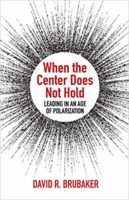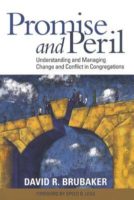Much of the current literature on congregations focuses on why and how congregations must change. On the ground, we celebrate congregational leaders who are able to “revive a dying church” or “grow a struggling synagogue.” And those of us who work with congregations are often called in to assist in designing or implementing a change process. In a time of dramatic changes in our congregational environments, skilled agents of change (both internal and external) are indeed sorely needed.
But the reality of congregational life is that every congregation includes not only “agents of change” but also “agents of stability.” Who are the agents of stability in a local congregation? They are often the individuals with the deepest memories of the history and practices of the congregation. They are the persons who may deeply value traditional music and ritual practices and thus may resist changes that are being introduced by those who insist the congregation must “change or die.” Because of this tendency, the agents of change tend to view those questioning their proposed changes as “change resistors” who must be “neutralized” for the change to be successfully implemented. Often this leads to explicit calls to move such change resistors “off the bus” so the change process can move forward.
Two kinds of change
Successful agents of change, however, learn to work WITH agents of stability rather than against them. The reason is quite simple—if a proposed change is to be successfully implemented into the structure and culture of a congregation, the agents of stability will need to be part of the process of adaptation and acceptance. This is the nature of evolutionary change in any organization—including a congregation.
Revolutionary change occurs when a pastor, priest or rabbi is summarily voted out or when one faction manages to expel another. But the paradox of revolutionary change is that usually not much changes. When the revolutionary agents of change in a religious system finally overwhelm the opposition the end result is invariably a diminished and depleted system where old patterns still continue.
In my experience, the congregations that are healthiest and most alive tend to display a delightful balance and mutual respect between the “agents of change” and the “agents of stability.” While the latter may appear at times to be the ones who resist change, there is usually something very precious in the history or tradition of the congregation that they are trying to preserve. If we can learn to value the agents of stability alongside the agents of change we will find that there is a delicate symmetry in congregational life that invites us to embrace both the new and the old. But if we demean those at either end of the spectrum we create destructive conflict and contested identities.
Let me offer two examples. First, a congregation that disrespected its agents of stability and paid a high price. Second, a congregation that worked to implement change while welcoming wisdom from its agents of stability.
The Worship Committee of First Downtown Church, with the prodding of the lead pastor and protestations from the Minister of Music, recently determined to transform its single worship service from “traditional” to “contemporary.” As part of that transformation, the Worship Committee agreed that the organ should be removed from its prominent place in the right front corner of the sanctuary and replaced by a drum set. The rationale for the change was that younger members were demanding a change in the style of worship and that others needed to “get on board.” The organist was informed that her services would no longer be required after Easter Sunday, and choir members were sent a short note thanking them for their past “gifts of music” and explaining the change of worship format.
The rumblings from choir members stayed mostly underground until the Sunday after Easter. When members entered the sanctuary that morning and saw that the organ had been replaced by a drum set the backlash intensified. The involuntarily-retired organist sat in the back and wept while many in the congregation refused to stand when the praise band leader invited them to do so. The “transformation” from traditional to contemporary worship might have been accomplished, but at an extremely high price.
In this admittedly exaggerated example, the agents of change simply overran the agents of stability who were urging a more incremental change process. One of the most important reasons to include the agents of stability in our planning processes is that they will alert the agents of change where to anticipate landmines in the change process. The second example illustrates this principle.
The Beth El congregation recently decided to revise its decision-making structure. Beth El is a reform synagogue with a board of trustees and a traditional committee structure, but the board is considering moving from standing committees to more organic teams. The board determined to first establish a representative task force to review the structure and deliberately recruited members who represented the range of diversity (including tenure) in the congregation itself.
At the first meeting of the task force the convener invited members to identify their tenure and current roles in the congregation. Two of the six members had been part of the congregation for more than 25 years and each had served in multiple roles on various committees. The convener commented that she would particularly welcome insights from these two members about what had worked well in the current structure, so that the strengths of the committee system would be respected in any transition to a team model.
In congregations where precipitous changes are rammed through with little participation and conversation, the agents of change are invariably in charge but fail to heed the voices of the agents of stability. And in congregations that are stuck and resistant to change the agents of stability seem to have the upper hand but are driving away the agents of change.
In those delightful congregations that have learned to value both ends of the spectrum there is both mutual respect and adaptive change. The agents of change heed the voices of the agents of stability, and the agents of stability have learned that they must welcome the ideas of the agents of change. These congregations possess a culture that embraces paradox—along with leaders who do the same.
Note: The “agents of change” in a congregation tend to be visionaries who see the big picture but often miss the details (like Moses in the Hebrew Scriptures), whereas the “agents of stability” tend to be capable managers who attend to details (like Aaron). A helpful resource that highlights the importance of both perspectives in terms of personnel management is When Moses Meets Aaron: Staffing and Supervision in Large Congregations, by Gil Rendle and Susan Beaumont.
David Brubaker has consulted with organizations and congregations in the U.S. and a dozen other countries on organizational development and conflict transformation. He is the author of Promise and Peril, on managing change and conflict in congregations, and When the Center Does Not Hold, on leading in an age of polarization. David recently retired from his role as Dean of the School of Social Sciences and Professions at Eastern Mennonite University, and is now a Professor Emeritus of Organizational Studies.



